What Part of the Cow Is Ribeye? This is a common question asked by those who enjoy a well-marbled steak. Ribeye is a popular cut of beef known for its juicy and flavorful taste, but not everyone knows where it comes from. Understanding the anatomy of a cow is important for meat lovers, as it can help them make informed choices when selecting beef cuts for cooking. In this article, we will delve into the specific part of the cow that gives us delicious ribeye and discover how it differs from other cuts. Whether you’re a seasoned grill master or just learning your way around the kitchen, read more about the part of the cow where ribeye comes from.
What is a Ribeye Steak?
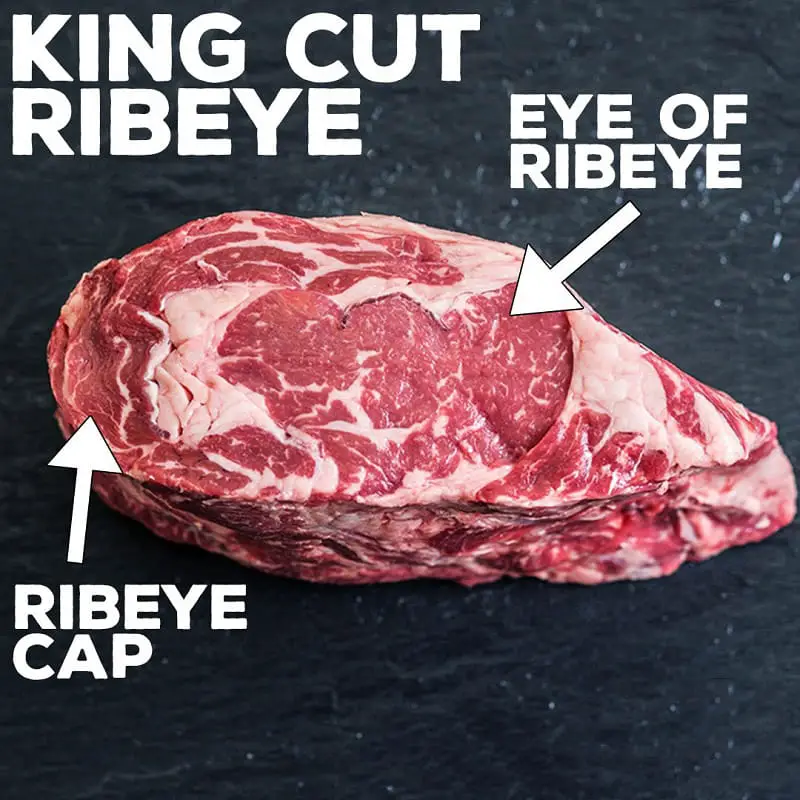
A Ribeye steak is a cut of beef from the primal rib cut of the animal. It is one of the most popular steak cuts known for its deep flavor and tender texture.
The ribeye steak is cut from the rib section of the animal. It is the area between the spine and the shoulder blade known for its tenderness, flavor, and marbling. It is the most tender cut of beef and is generally the most expensive cut.
The ribeye steak is one of the most popular cuts and is often served from medium rare to medium. This cut of beef is so tender that it can be served without steak sauce or even marinade. The steak can be pan-seared, grilled, or broiled and is often served with various side dishes such as potatoes, vegetables, or salad.
What Part Of The Cow Is Ribeye?
According to factual data, the Ribeye Steak is derived from the rib primal, a section of the cow that spans from ribs six through twelve. This portion is known for producing the most flavorful and tender meat on the animal, whether bone-in or boneless. A good quality Ribeye Steak is always sure to please the palate with its rich marbling and buttery texture.
Other Names For Ribeye
If you’re a steak lover, you’ve likely heard of the ribeye cut of beef. It’s one of the most popular pieces of steak, and it’s always a crowd-pleaser. But did you know that ribeye has several other names?
First, let’s start with Delmonico. This cut is from the ribeye area of the cow, but it’s cut from the rib end rather than the center. This makes it a more tender cut of steak and gives it a unique flavor. The Delmonico is a great choice for those who prefer a mellow, buttery flavor.
Next, we have Spencer. This cut is similar to the Delmonico but cut from the short loin area. It’s slightly more tender than the ribeye and has a more robust flavor. The Spencer is a great option if you’re looking for a steak with a bolder taste.
Finally, there’s the Cowboy Cut. This cut is taken from the ribeye area of the cow, but it’s cut from the rib end. It’s slightly thicker than the ribeye and has a more robust flavor. It’s also a great option if you’re looking for a steak with a bolder taste.
What Are The Characteristics Of A Ribeye Steak?
Let’s look at ribeye steak’s unique characteristics and why it deserves a spot on your next dinner plate.
- Appearance: A ribeye steak has a distinct appearance that sets it apart from other cuts of meat. It has a deep red color with a layer of fat marbling throughout. This fat marbling helps to keep the steak moist during cooking and is the key to its delicious flavor.
- Tenderness: Ribeye steak is known for its tenderness. This is partly due to the high-fat content and the fact that it is taken from the rib area of the cow. This area is relatively low in muscle, which makes the steak more tender.
- Flavor: The fat marbling that is found in ribeye steak is what gives it its unique flavor. Fat melts during cooking, producing a juicy and flavorful steak.
- Cooking Method: Ribeye steak is best cooked over high heat. This helps to sear the fat and develop a flavorful crust. Grilling, pan-frying, and broiling are all great methods of cooking ribeye steak.
How Many Ribeye are in a Cow?
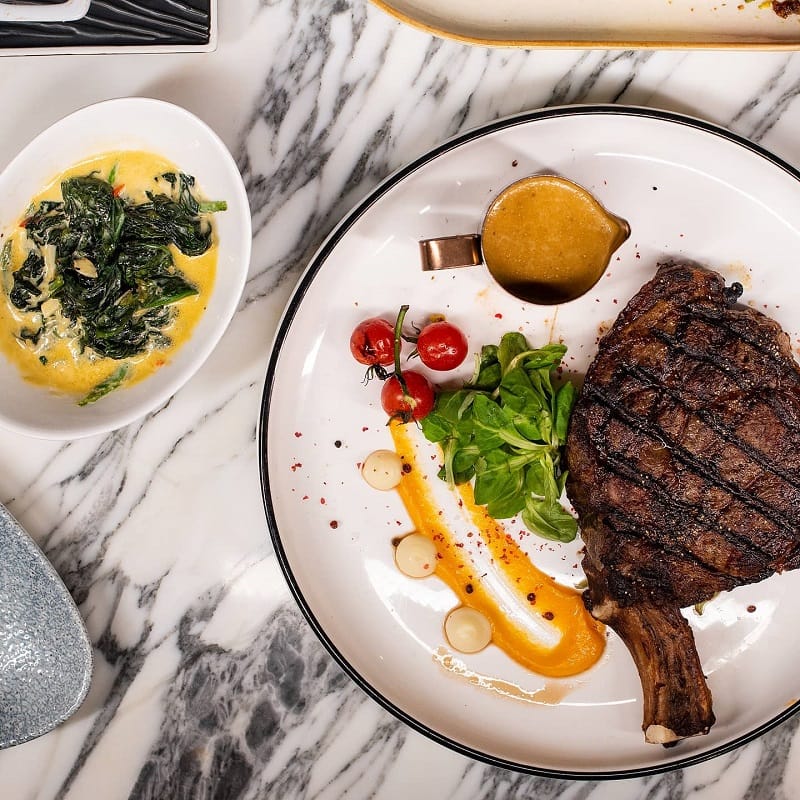
If you’re wondering how many ribeye steaks you can get from a cow, factual data shows that an average cow will produce about 14. While this might seem like a small number, it’s quite a generous amount compared to other cuts of beef.
In addition to the ribeyes, a cow will also yield a variety of other cuts like sirloin steaks, t-bones, and roasts. For those interested in purchasing beef in bulk directly from a farmer, half of a cow will typically include around 12 roasts and 14 t-bone steaks, along with those 5 sirloin and sirloin tip steaks. Of course, these numbers can fluctuate depending on the size and weight of the cow.
What Is The Best Cut Of Ribeye Steak
The answer to that question depends on various factors, including cooking methods, the amount of fat on the steak, and personal preference. To help you choose the best ribeye steak cut for your next meal, here’s a look at the different cuts and their characteristics.
- The Cowboy Cut: This hearty and flavorful cut is full of marbling, making it the perfect choice for pan-searing or grilling. It has a large, juicy center and is best-served medium-rare.
- The Ribeye Cap: This cut is smaller than the Cowboy Cut but still packs a flavorful punch. It’s flavorful and great for grilling, roasting, or pan-searing.
- The Ribeye Club: This cut has a unique shape resembling ribeye steak. It’s full of fat and flavor and perfect for grilling or pan-searing.
- The French Cut: This cut is a bit on the leaner side, making it a great choice for pan-searing, grilling, or roasting. It has a more delicate flavor than the other cuts and is best served rare or medium-rare.
- The Filet Mignon: This cut is the most tender and leanest of the ribeye cuts. It’s great for roasting or pan-searing and is best-served medium-rare.
The Cowboy Cut is your best bet if you’re looking for a hearty steak with plenty of flavors. If you’re looking for something a bit leaner, then the Ribeye Cap or Filet Mignon are great choices. And if you’re looking for something more delicate and flavorful, then the French Cut is a perfect choice. No matter your preference, you can find the perfect ribeye steak cut for your next meal.
How Can One Determine The Quality And Freshness Of Ribeye At The Grocery Store Or Butcher Shop?
When you purchase the highest quality ribeye steak, you’ll surely get the ideal flavor and tenderness for your meal. Here are a few tips to help you determine the quality and freshness of ribeye at the grocery store or butcher shop.
- Check for Marbling. Marbling is the white, fleck-like fat running throughout the meat. Good marbling will help give the ribeye greater flavor and tenderness. When checking for marbling, look for an even distribution of fat throughout the meat and make sure the fat isn’t too thick.
- Consider the Color. The ideal ribeye should be a deep, rich red color. If you notice the meat is too pale or has a grayish hue, it’s likely, not fresh and should be avoided.
- Ask About the Age. Ribeye steak is typically aged 14 to 21 days, so be sure to ask the butcher or grocery store clerk how long the meat has been aged.
- Smell the Ribeye. Fresh ribeye will have no strong smell and should not smell off or “fishy.” If the smell is strong or off, it’s likely, not fresh.
- Feel the Ribeye. Good quality ribeye will have a firm texture and spring back when pressed. If the meat is too soft, it’s likely, not fresh.
Is Ribeye Steak Expensive?
Ribeye steak is known to be one of the most expensive cuts of steak. Its high price is due to the fact that it is a premium cut, with the ribeye cap being the most expensive part of the steak. The high cost is also attributed to the quality of the meat, as it is sourced from premium Angus beef and is often raised without antibiotics, hormones, or steroids. The average price for a good-quality ribeye steak ranges from $12.99/lb to $14.99/lb. While it may be a bit pricey, buying in bulk or searching for sales is a great way to enjoy this delicious steak without breaking the bank.
Read more:
- Brisket Vs Pulled Pork
- Meat Lover’s Guide: How Many Ribeyes In A Cow?
- Wagyu Vs Angus
- Where Does Steak Come From
Health Benefits Associated With Eating Ribeye Steaks
The ribeye steak is packed with flavor, but it also offers a variety of health benefits. From helping to improve your heart health to aiding in muscle growth, ribeye steaks offer a variety of health benefits that may surprise you.
- Heart Health: The ribeye steak is a great source of healthy fats. While it does contain saturated fat, it also contains a generous amount of monounsaturated fats, which are great for heart health. These healthy fats help reduce cholesterol and control blood pressure levels. Also, ribeye steaks are rich in vitamin B12 and zinc, which are important for maintaining a healthy heart.
- Muscle Growth: The ribeye steak is one of the best protein sources and essential amino acids, making it ideal for muscle growth and repair. Additionally, ribeye steaks contain creatine which helps to improve strength and endurance. This is why ribeye steaks are often recommended for athletes and bodybuilders.
- Weight Management: A ribeye steak is a great option for those who want to maintain weight and stay fit. Since it is relatively low in calories and fat, it won’t add to your waistline like other cuts of beef. Additionally, ribeye steak is rich in iron, which helps to boost your metabolism and keep your weight down.
- Cancer Prevention: Ribeye steaks are a great source of selenium, an essential mineral that helps to reduce your risk of developing certain types of cancer. Selenium helps to protect cells from damage that can lead to cancer. Additionally, ribeye steaks are high in vitamin B12, which helps to reduce inflammation and protect you from cancer.
Prime Rib vs. Ribeye Steak
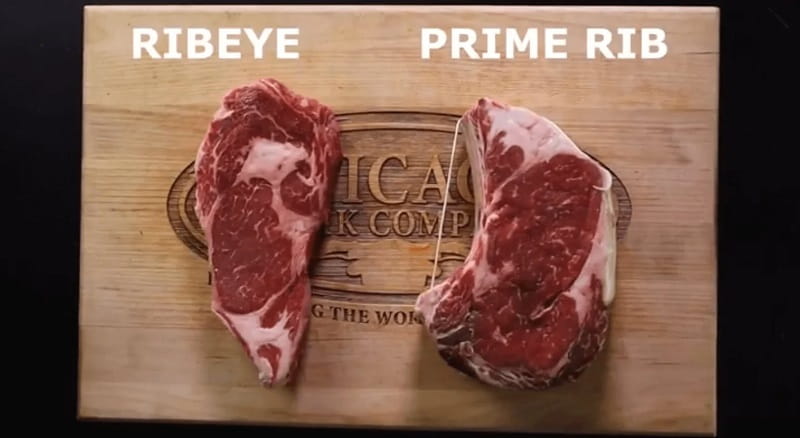
Prime rib and ribeye, both cuts of beef, are highly desirable and widely popular, but which is the better choice for your meal?
There is no clear winner when it comes to the flavor of prime rib and ribeye steaks. Both cuts of steak have a rich flavor, with prime rib slightly more tender and ribeye steak having a more robust flavor. The major difference between the two cuts lies in the fat content. Prime rib is slightly fattier, while ribeye steak is leaner.
In terms of texture, prime rib and ribeye steak share similar characteristics. Both cuts of beef are tender and juicy, with the prime rib slightly more delicate. Prime rib is more likely to retain more of its juices when cooked, making it a more flavorful choice. Ribeye steak, on the other hand, is slightly firmer and can stand up to higher cooking temperatures.
When it comes to price, prime rib, and ribeye steak are both on the more expensive side. Prime rib costs more due to its higher fat content, while ribeye steak is usually less expensive due to its leaner cut.
Prime rib and ribeye steak are best-cooked medium-rare when preparing the steak. Prime rib should be cooked at a lower temperature than ribeye steak and allowed to rest for at least 10 minutes after cooking. Ribeye steak should be cooked at a higher temperature and not allowed to rest.
Prime rib is the better choice if you’re looking for a more flavorful steak. If you’re looking for a leaner cut of steak, ribeye steak is the way to go. Whatever you decide, you’ll surely get a fantastic steak dinner with either prime rib or ribeye steak.
How to Choose Great Ribeye Steaks?
Here are some tips to help you pick out the perfect ribeye steak.
- Look for marbling. Marbling is the white streaks of fat that run through the steak. The more marbling, the more tender and flavorful the steak will be.
- Check the color. The best ribeye steaks are deep red with a bit of pink in the center.
- Don’t be afraid to get hands-on. Could you pick up the steak and squeeze it? It should have a bit of a bounce back when you let go.
- Choose the right size. If you’re grilling, go for a larger steak to get good grill marks. If you’re pan-frying, a smaller steak will cook more evenly.
- Buy the best quality you can afford. Ribeye is a high-quality cut of steak, so you don’t want to skimp on the quality. Look for organic, grass-fed beef if you can find it.
Is There A Difference Between Prime And Choice Grade Ribeye Steaks?
Here’s everything you need to know about prime and choice-grade ribeye steaks to make the right decision when you’re at the butcher.
First, let’s start with the basics. Prime-grade steaks come from the top 2% of the cattle. They’re aged for longer, have more marbling (intramuscular fat), and are more tender and juicy. Choice-grade steaks come from the top 6-8% of the cattle, and while they’re still of high quality, they’re not quite as tender and juicy as prime.
The most obvious difference between the two is the price. Prime-grade steaks are more expensive than choice-grade, and the difference can be quite substantial. If you’re looking for a delicious steak dinner without breaking the bank, the choice grade is your best bet.
When it comes to flavor, the difference between prime and choice-grade ribeye steaks is quite noticeable. Prime-grade steaks have more marbling, which means more fat, and fatter means more flavor. Choice-grade steaks, on the other hand, have less fat and, thus, less flavor. So if you’re looking for a steak with plenty of flavors, the prime grade is the way to go.
When it comes to texture, prime-grade steaks are more tender and juicy, while choice-grade steaks can be a bit tougher. Again, if you’re looking for a steak that’s both tender and juicy, the prime grade is the way to go.
Finally, prime-grade steaks also hold up better when cooked. Due to their higher fat content, they tend to remain moist and juicy even when cooked to your desired doneness. Choice-grade steaks, on the other hand, can dry out more quickly and become tough if they’re overcooked.
What Types Of Cooking Methods Are Best For Cooking A Ribeye Steak?
One of the most popular methods for cooking a ribeye steak is grilling. This technique is great for giving the steak a nice crisp outside while keeping the inside juicy and tender. The key to grilling a ribeye steak is to keep the temperature high and the cooking time short. You want to keep an eye on the steak while it’s cooking to ensure it doesn’t get over or undercooked. When cooking a ribeye steak on the grill, you aim for an internal temperature of 130-140 degrees.
Another popular cooking method for ribeye steak is pan-searing. This is a great way to get a nice crust on the outside of the steak while keeping the inside tender and juicy. To pan-sear a ribeye steak, you’ll want to preheat a cast-iron skillet over medium-high heat. Once the skillet is hot, add a tablespoon of oil to the pan, and then add the steak. Cook for three minutes on each side, flipping once halfway through. You’ll want to aim for an internal temperature of 130-140 degrees for the best results.
If you’re looking for a more traditional cooking method for your ribeye steak, you should consider cooking it in the oven. Oven roasting is a great way to ensure your steak comes out tender and juicy. To oven roast your steak, preheat your oven to 350 degrees and then place your steak in a roasting pan. Roast the steak for 25 minutes, flipping it halfway through. When it’s finished, let it rest for five minutes before serving.
How To Cook Rib-Eye Steak
Ingredients:
- 1-2 rib-eye steaks
- Salt and pepper to taste
- 1 tablespoon of olive oil
- Optional: Garlic, rosemary, and thyme
Instructions:
- Preheat the oven to 350°F.
- Rub the steaks with olive oil and season with salt and pepper.
- Place the steaks on a rack in a roasting pan and place them in the oven.
- Cook 10 – 12 minutes for medium-rare or 12 – 15 minutes for medium.
- Optional: Add garlic, rosemary, and thyme to the steaks while they cook for added flavor.
- Remove the steaks from the oven and let them rest for 5-10 minutes before serving.
Enjoy your perfectly cooked rib-eye steak!
Notes:
Temperatures for Steak Doneness
- Well done: 155-165 degrees Fahrenheit
- Medium well: 145 degrees Fahrenheit
- Medium: 135-145 degrees Fahrenheit
- Medium rare: 130 to 135 degrees Fahrenheit (most people prefer it this way)
- Rare: 120-130 degrees Fahrenheit
How Can You Tell When A Ribeye Steak Is Cooked To The Perfect Level Of Doneness?
The most important factor when it comes to steak doneness is temperature. For a ribeye steak, the target temperature should be 135-145 degrees Fahrenheit. At this temperature, the steak will be cooked through and have a slightly pink center, which is the ideal level of doneness. Anything higher than 145 degrees will result in a steak that’s overcooked and dry.
Using a meat thermometer is the easiest way to tell if your steak is cooked to the perfect level of doneness. A digital thermometer inserted into the thickest part of the steak will give you an accurate reading. The steak is cooked to rare, medium doneness if the temperature is 130-135 degrees.
Another method for testing doneness is to use the poke test. Gently press the steak with your finger and then release. If the steak springs back quickly, it’s likely done. It needs to cook a little longer if it doesn’t jump back.
Finally, you can use the “finger test” to gauge doneness. Press your index finger against the tip of your thumb and then press against the steak. If the steak has a texture similar to your fingertip’s, it’s probably done.
Common Mistakes People Make When Preparing A Ribeye Steak
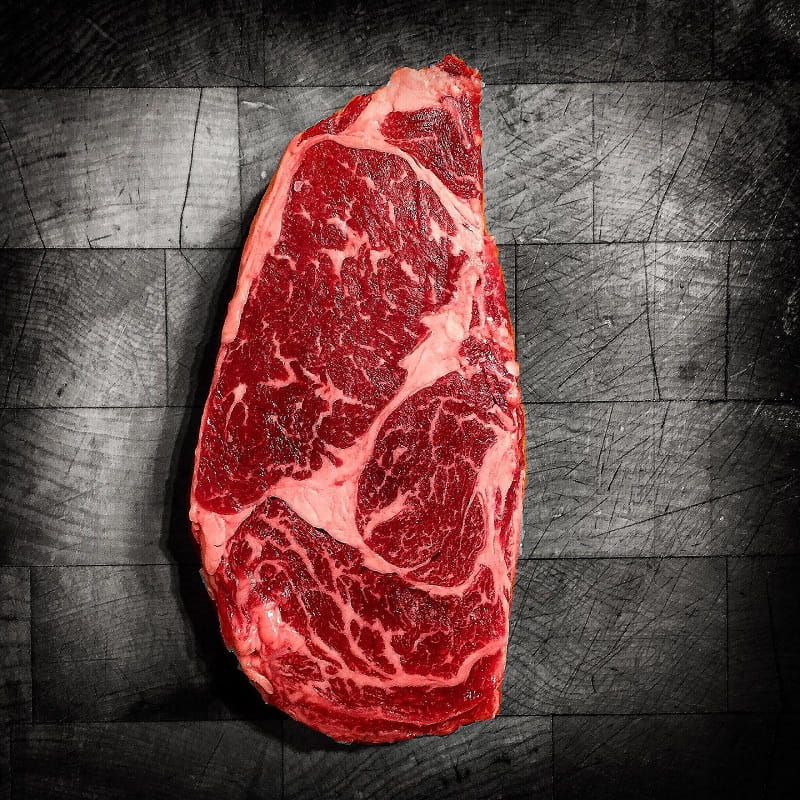
To ensure that you get a perfectly cooked ribeye steak every time, here are some of the common mistakes to avoid:
- Not letting the steak come to room temperature: If you put a cold steak on a hot grill or pan, the outside of the steak will cook faster than the center. This will cause the steak to be overcooked on the outside and raw on the inside. Therefore, it’s essential to let the steak come to room temperature before cooking.
- Not using enough oil: If you don’t use enough oil when cooking a steak, it will stick to the pan or grill and cause uneven cooking. To prevent this, make sure to use enough oil to coat the steak and the pan or grill.
- Not seasoning the steak properly: If you don’t season the steak properly, the flavor of the steak will be dull and bland. To get the most flavor out of the steak, season it generously with salt and pepper.
- Not searing the steak: Searing the steak is an important step that helps seal the juices and add flavor. When you’re searing the steak, use high heat and don’t move it until it has developed a nice, golden-brown crust.
- Overcooking the steak: When it comes to a ribeye steak, it’s important not to overcook the steak. A ribeye steak should be cooked to medium rare for the best results. If you overcook the steak, it will become tough and dry.
FAQs About What Part Of The Cow Is Ribeye
How Does Marbling Affect The Quality Of Ribeye, And What Is The Ideal Level Of Marbling?
Marbling, or the amount of fat dispersed throughout the muscle fibers of beef, significantly impacts the quality of ribeye steak. The presence of marbling enhances the eating experience in terms of tenderness, juiciness/moisture, and flavor. However, the ideal level of marbling is crucial – too little, and the beef may be too tough or dry; too much, and it may have a negative impact on the flavor. The best type of marbling is fine marbling, which is comprised of small, thin flecks of fat within the lean muscle that melts at temperatures of 130 degrees or higher. USDA Prime certification is only given to those steaks with the best marbling, making it the highest rating for steak quality.
What Kind Of Marinades Or Rubs Pair Well With Ribeye Steaks?
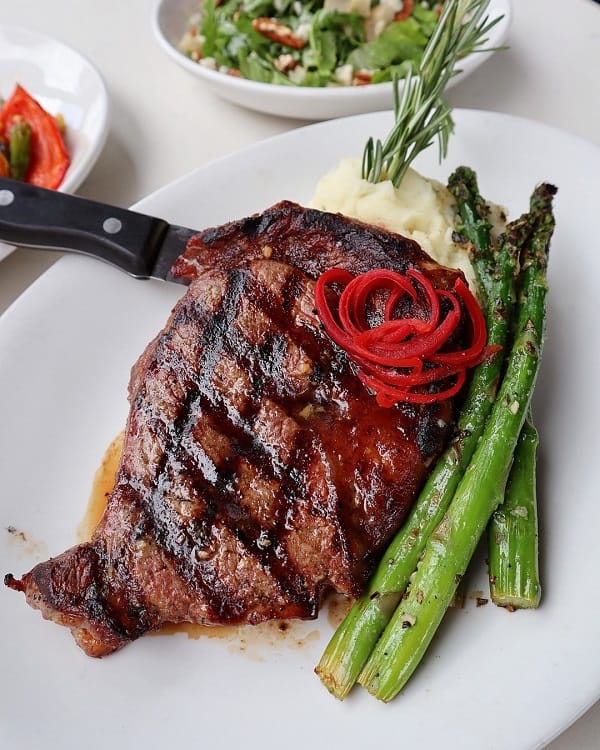
When cooking a delicious ribeye steak, marinades and rubs can enhance the flavor and tenderness of the meat. Many marinades include acidic liquids like lemon juice or vinegar, which help to tenderize the steak while adding a desired flavor. A dry rub of herbs and spices like basil, cinnamon, or rosemary can also be applied to the steak for added depth of flavor.
Basic ribeye seasoning usually includes salt and pepper, but a homemade brown sugar rub can add a flavorful crust to the steak. Marinating ribeye steaks with garlic, lemon slices, and olive oil is a delicious option for those who prefer fresh herbs.
Another exciting marinade option is Citrus Marinated Ribeye Steaks, which include orange, lemon, rosemary, and garlic for over-the-top flavor. No matter the preference, experimenting with different marinades and rubs can take a ribeye steak to the next level of deliciousness.
Conclusion
So when you’re asking, “What part of the cow is ribeye?” the answer is the primal rib section of the cow. This part of the cow is known for its marbling and juicy, tender texture, and it’s the source of the beloved ribeye steak.
Whether you’re a steak enthusiast or a home chef, understanding the different parts of the cow is essential for selecting the best cuts of beef. So the next time you wonder what part of the cow is ribeye, you’ll know the answer.
References:
- https://www.ncbi.nlm.nih.gov/pmc/articles/PMC8100480/
- https://www.mychicagosteak.com/steak-university/season-ribeye-steak

Hey readers! Chip Holland here, and I’m a Manager of this website. My passion for writing about it only matches my passion for BBQ. Follow my blog for mouth-watering recipes, tips, and tricks for the perfect smoke, grill, and BBQ. I’m sure you won’t be disappointed!
